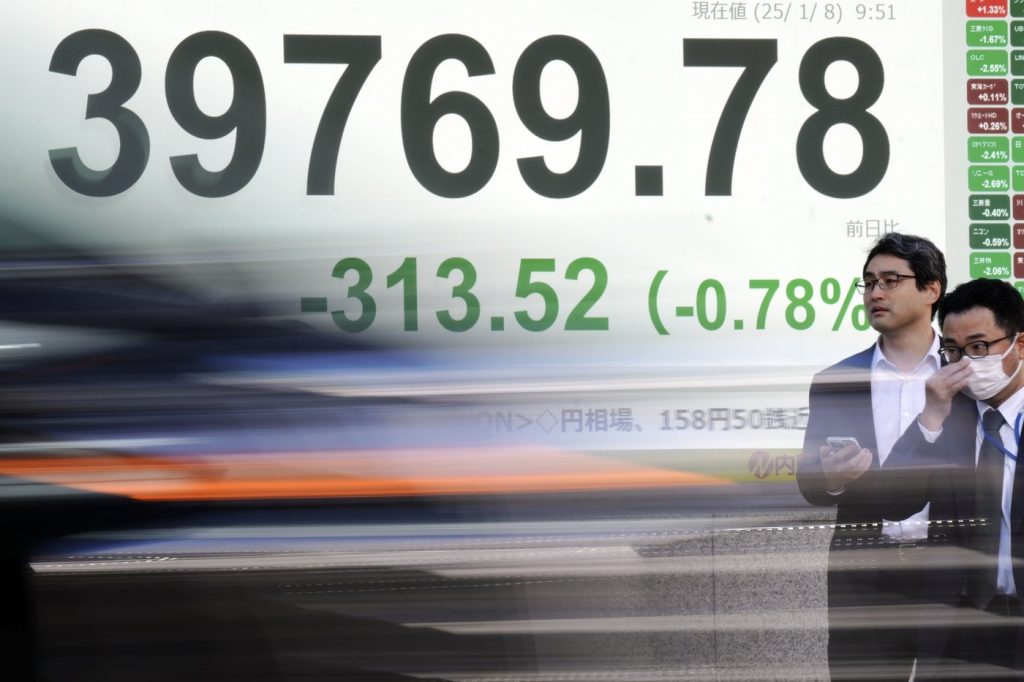Asian markets experienced a predominantly downward trend on Wednesday, influenced by a decline in shares on Wall Street despite positive developments in the U.S. jobs market and business activity reports. While Asian stock indices fell, U.S. futures and oil prices saw an increase.
The Nikkei 225, Japan's primary stock index, decreased by 0.3%, closing at 39,981.06. Concurrently, the U.S. dollar was trading at 157.97 yen, slipping slightly from the previous figure of 158.06. Hong Kong's Hang Seng index dropped 1% to 19,255.76, while the Shanghai Composite index remained nearly flat at 3,230.17. Notably, shares of Tencent fell 2.4%, and CATL, the world's leading battery manufacturer, saw a 1.8% decline. These companies were included in a U.S. Defense Department list that allegedly connected them to China's military.
In contrast, South Korea's Kospi index surged by 1.2% to 2,521.05, and Australia's S&P/ASX 200 experienced a gain of 0.8%, ending at 8,349.10.
On Tuesday, the S&P 500 experienced a downturn of 1.1%, closing at 5,909.03 after surrendering earlier gains. The Dow Jones Industrial Average fell 0.4% to 42,528.36, while the Nasdaq composite faced a significant decline of 1.9%, ending at 19,489.68. The stock market's drop occurred despite a backdrop of strengthening bond yields, which surged following the release of positive economic reports.
One report indicated that U.S. employers had more job openings than anticipated at the end of November. Another report revealed that business activity in finance, retail, and services had grown at a faster-than-expected pace in December. While these reports were generally favorable for job seekers and reduced recession fears, they also raised concerns regarding inflation, potentially impacting the Federal Reserve's approach to interest rates.
The Federal Reserve initiated interest rate cuts in September to stimulate economic growth, but there are increasing signals that they may slow this easing process. The potential for tariffs from President-elect Donald Trump adds to the concerns over inflation, which has stubbornly remained just above the Fed's 2% target. Furthermore, December's service industries report from the Institute for Supply Management also indicated accelerating price increases, adding to inflation worries.
Amidst these dynamics, expectations for fewer rate cuts in 2025 have gained traction, which has contributed to the rise in longer-term Treasury yields. Such yields are compelling for investors typically inclined toward stocks, exerting downward pressure on equity prices. The yield on a 10-year Treasury bond rose to 4.69% from 4.63%, following the release of encouraging economic reports, a substantial increase from 4.15% in early December.
As apprehensions regarding a decelerating U.S. economy diminish and the 10-year yield firmly surpasses 4.50%, strategists at Bank of America, led by Ohsung Kwon, suggest that the market may be entering a "good news is bad news" phase. This situation heightens expectations for the upcoming U.S. job market report, anticipated on Friday, which economists forecast will reveal a slowdown in hiring, projecting an increase of 156,500 jobs in December according to FactSet.
In the energy sector, benchmark U.S. crude oil saw an uptick of 42 cents, trading at $74.67 per barrel, while Brent crude also rose, gaining 41 cents to reach $77.46 per barrel. In currency markets, the euro was priced at $1.0346, a slight rise from $1.0341.










